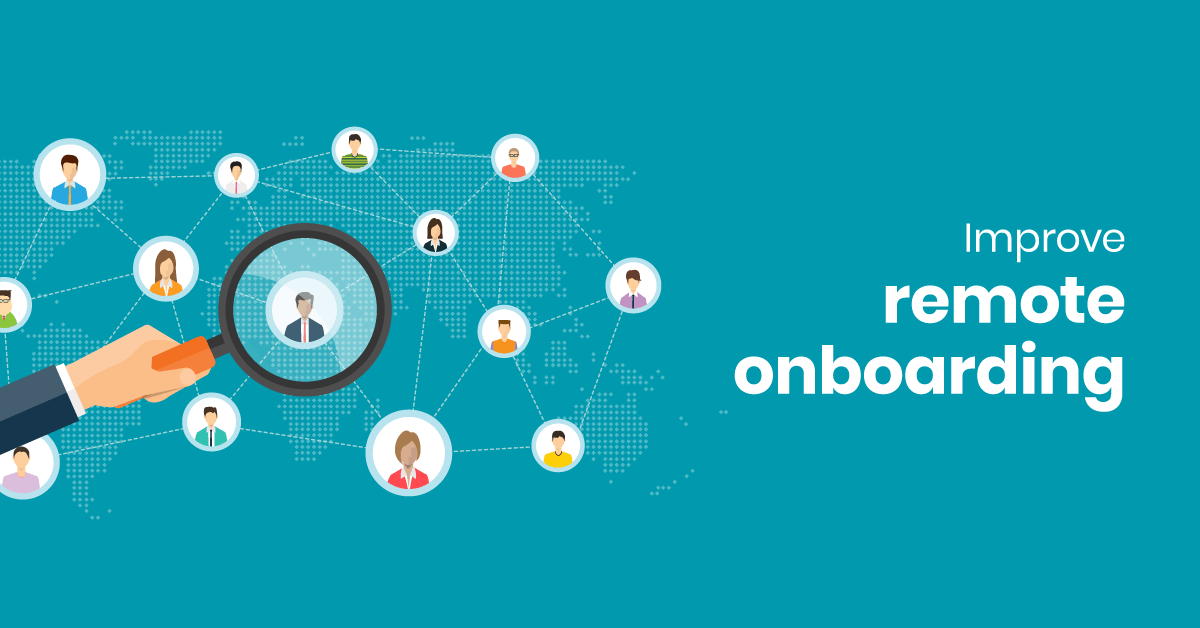The shift to remote work in the wake of the pandemic has transformed a lot of business functions — including onboarding. The sudden and unexpected rush to go remote hurried digital transformation, and many organizations created interim plans.
But you, like many companies, may plan to keep some of these changes going forward. Remote work is no longer “just a temporary solution.” More and more people will be looking for remote job opportunities. And if you want to attract and retain top talent, now is the time to rethink your onboarding process and make it a springboard into a healthy and long-term employee relationship.
How is remote onboarding different?
Onboarding is how the relationship between the company and the employee starts. And it has a big impact on how it continues. According to SHRM, companies with a strong onboarding process improve employee retention in the first three years by 69%.
The key to success with virtual onboarding is to understand the strengths and challenges of doing things remotely.
The good…
Remote onboarding is more streamlined. And faster. The literal process of signing on to the team is simplified by the conveniences of reduced paperwork. Contracts and manuals can be distributed, signed, and filed digitally.
The bad…
Physical distance can make routine parts of onboarding remote employees more complicated or even off-putting. For example, equipment and account setup can get challenging. It’s less convenient when you have to ship computers and office supplies. And not having an IT team member present can add to the challenge. Employees are left to troubleshoot on their own or get virtual coaching.
… and the ugly
Perhaps the greatest challenge with remote onboarding is the lack of in-person communication. Never having physically met managers, HR reps, or team members can leave new hires feeling isolated. If the process is too streamlined, you run the risk of making it impersonal and disengaging.
Building a better remote onboarding experience
Your remote onboarding process should achieve some very specific goals. On the one hand, you want to make sure your remote employees are up to speed and start being productive as soon as possible.
But there’s a long-term factor as well. The business impact of onboarding is more than just immediate productivity. Long-term success and employee retention both depend heavily on employee satisfaction.
If you want to be successful and competitive, you can’t just replicate what you’ve already been doing in person. You need to create new, innovative methods of helping onboard remote employees. If you want a truly effective onboarding experience, building a strong connection is critical.

3 steps for effective remote onboarding
When hiring employees remotely, it’s best to break down your onboarding plan into 3 steps.
Step 1: Before the first day
A lot of what sets the stage for successful employment should happen before day 1. After interviews are done and an offer has been accepted, be ready to let your new hire know exactly what to expect. Don’t leave them hanging out, waiting to hear from you, and unsure what to do in the meantime.
- Communicate next steps right away. Then follow through with information and help that makes employees feel welcome and assures them you’re invested in their success. Consider the following items for your remote onboarding checklist.
- Prepare a training plan. If the employee needs to brush up on specific skills or attend compliance training, be ready with a plan. Let them know in advance what to expect. Sign them up to attend online instructor-led classes or show them how to log on to your LMS and complete self-paced training.
- Provide helpful “paperwork.” Contracts and employee handbooks can be distributed, signed, and filed all online. You can also help orient employees by providing org charts or company directories. These help as they get comfortable with their coworkers and the chain of command.
- Take care of the tech part. The equipment you’re providing should be shipped to arrive before an employee’s first day. Getting new tech and accounts set up can be difficult. Walk new employees through the process with videos or brief training sessions. You could also download and install software on their computer in advance. Then make sure they have all the info they need to sign in and authenticate accounts to get things up and running.
- Make it personal. Consider having a few coworkers sign up for an informal “coffee” meetup to chat and introduce company culture. Show your new hires you recognize and value them. Have their manager send a personal welcome letter. Send a video message about the company’s vision and values. Also, send company swag. For example, a mug or hoodie with the company logo is a simple way to help people feel like a part of the team.
Step 2: On the first day
Make sure you give new hires a warm welcome. Besides the necessary tasks (e.g. signing contracts, going over company policies, etc.), there’s plenty you can do to deliver a nice first-day experience. And technology can help with that.
- Video should play a big part. For remote workers, video conferencing is as close to face-to-face as it gets. Calls are helpful, but video chat gives more sense of an in-person experience. Set up multiple sessions throughout the day to get them interacting as much as possible. Involve the team, not just HR and the direct manager. Have an informal team meeting to welcome them, answer questions, and introduce them to the team culture in general.
- Make training engaging. If training is a part of onboarding, make it engaging and interactive. Sitting in front of a screen just receiving information for too long can be exhausting. Encourage conversation. Include interactive features like quizzes and polls or breakout rooms where they can talk with other trainees.
- Take breaks. There’s a lot of ground to cover on that first day. And the convenience of technology makes it easy to get everything in. There’s no time wasted in commutes, moving from office to office, or gathering everyone in the conference room. But remember the effects of online meetings. Zoom fatigue is real. Build breaks into the schedule throughout the day. Consider including the cost of takeout lunch for the new hire or even all their team members. It’s a simple perk, but one that goes a long way toward showing appreciation and concern for employee wellbeing.
- Apply a buddy system. Meeting a lot of new people in one day can be overwhelming. Consider having someone from your organization serve as an onboarding “buddy” — someone to welcome and go through the process with them. They’ll be a face the new hire will recognize. They’ll also be able to answer questions that come up as they transition from one part of the process to the next.
Step 3: Day 2 and beyond
Onboarding doesn’t end on a new hire’s first day — or even first week. So, let’s talk about the next steps. Here are a few activities you can include to ensure onboarding isn’t just you ticking boxes, but helping you unlock your new hire’s potential,
The focus should go beyond week one. Keep the momentum and enthusiasm for the job high — it can easily drop after the initial welcome.
- Keep up opportunities to engage and collaborate. Schedule team meetings, formal and informal. Aside from the regular team or all-hands meetings, consider including team-building activities. Set up Slack channels or social media groups where people can interact informally. This creates social connection and provides opportunities for quick, casual conversations about issues or questions that come up.
- Check in regularly. Ensure employees have the resources they need on an ongoing basis. Ask for feedback on a regular basis to see how things are going. Survey employees about their experience a month — or longer — out. How’s their enthusiasm? Are they feeling as productive as they expected? What will help them?
- Let them know they’re seen. Don’t let the reduced visibility affect employees’ presence. Keep them in mind for active and important projects. Have regular touchpoints for projects they are working on.
Remote onboarding can be personal and consistent
The challenge with onboarding remote employees is that it can turn into an impersonal process. The beauty is that it can also be a consistent, well-documented process, identical for every employee. With the right plan, it’s possible to overcome the challenge while maintaining efficiency.
You can rely on technology to tackle repetitive parts of the process (e.g. creating a virtual employee handbook, building onboarding online training sessions that are automatically assigned to new hires, etc.). This will give you more time to manage the more “human” parts of onboarding.
Technology can help with those, too. From team-building apps and communication tools to LMS reports that show you where new hires are struggling. Then, you can adjust the process so that each new hire gets the most out of it.
Start with a plan for career success
Remote onboarding shouldn’t just be the online version of in-person onboarding. Your process provides an opportunity to address the challenges of isolation and disconnect many remote workers face. It’s a chance for your company to create a truly remote-friendly work environment.
Build a strong relationship from the moment of hire, and you’re likely to continue successfully well into an employee’s career with you.



